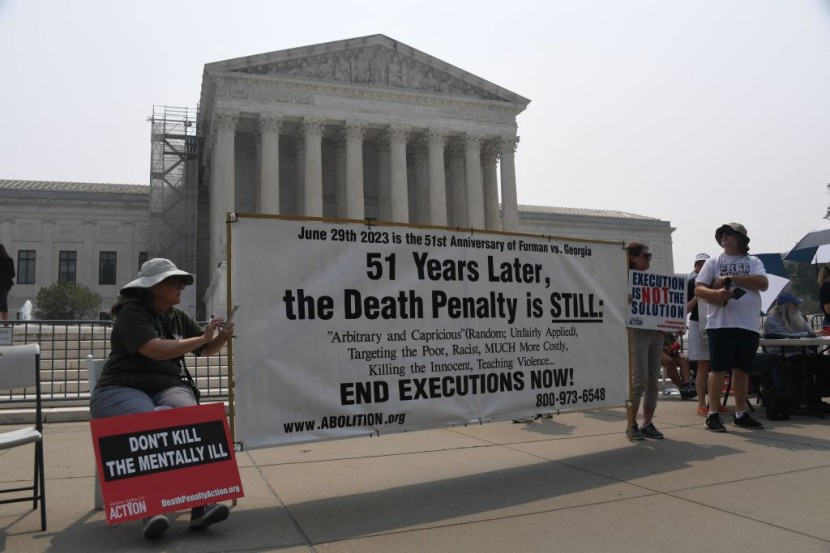A new legislation has been introduced to the state of Ohio to permit the use of nitrogen hypoxia as a method for carrying out the death penalty. The law aims to put life back into the state's stalled capital punishment system.

Ohio Attorney General Dave Yost announced the legislation with state Representatives Brian Stewart, Phil Plummer, and Executive Director Lou Tobin of the Ohio Prosecuting Attorneys Association.
"There must be accountability for offenders convicted of the most heinous crimes and prisoners who continue to flout the law behind bars," Yost said.
"The pursuit of justice is a journey, and closure remains elusive for victims' families until a sentence is fully executed. Ensuring that the consequences align with the severity of an offense is essential to providing solace to grieving relatives."
Nitrogen hypoxia garnered national attention when Alabama used the method to carry out the death sentence of murderer Kenneth Eugene Smith, becoming the first state in the United States to exercise the procedure. Nitrogen hypoxia is a colorless and odorless gas, and when implemented on an inmate, the inmate only breathes the nitrogen in, leading to oxygen deprivation and a state of rapid unconsciousness before death.
Ohio last performed an execution by lethal injection on July 18, 2018, over five years ago. Numerous reprieves were granted, mostly in part due to the reluctance of pharmaceutical suppliers to provide lethal drugs to the Ohio Department of Rehabilitation and Correction for executions.
Attorney General Yost hopes that nitrogen-- widely available and easily sourced-- can break the impasse of the unavailability of drugs for lethal injection.
Under the new legislation, manufacturers, suppliers, and distributors that provide lethal injection drugs to the state would receive indefinite confidentiality rather than the current two-year limit. The drug suppliers would also receive similar courtesy.
"As long as capital punishment remains the law in Ohio, the law should be followed - and duly enacted sentences should be carried out to give victims' families the justice and finality they deserve," sponsor Stewart, R-Ashville said. "Providing an additional method for carrying out capital punishments is necessary to ensure Ohio can continue to impose these sentences in response to the most heinous crimes committed in our state."
Plummer, R-Dayton added, "By using nitrogen hypoxia, we are giving the system an additional resource for holding accountable those who have committed heinous crimes. It is time that we stop postponing executions and give the families of victims the closure that they deserve."
Tobin echoed their thoughts, noting that they will continue to work to ensure the new death penalty measure is "fair and accurate."
Yost adamantly emphasizes the need to explore the death-penalty conversation even further as a way to give voice to victims' families.
What Are The Ethical Implications?
Last year, Governor Mike DeWine signed into law an animal cruelty bill banning the euthanization of pets with any gas not used as an anesthesia, like nitrogen. This promptly drew criticism from opponents against the bill, raising the question of its use on humans.
"That in and of itself does not make that execution inhumane or unconstitutional," said Michael Benza, Case Western Reserve University School of Law Professor. "The court has repeatedly pointed out that an amount of suffering, even a significant amount of suffering, is not what is prohibited by the constitution."
A different proposed bill is also running through the statehouse-- one that would abolish the death penalty altogether.
Media witnesses at Smith's execution in Alabama reported that he "shook and writhed," appearing to be in distress for several minutes as his body suffocated.
In response to media questions about the use of the death penalty in Ohio, AG Yost said that death-row exonerations proved that the "system works."
However, DPIC research shows that 10 of 11 Ohio death-row exonerations involved official misconduct, a finding at odds with his statement.
Governor DeWine and Gary Mohr, former director of the Ohio Department of Rehabilitation and Correction, are among the prominent figures who have expressed grave concern over the proposed legislation.
An execution method should be "a proven method that peacefully ends life," said Mohr.
He said that he was "not convinced" that nitrogen gas "meets [his] belief that people shouldn't struggle" and noted that staff and viewers would be traumatized watching a person struggle during an execution. Mr. Mohr supervised 15 executions in his previous role and has since felt misgivings about the death penalty.
"Having been personally involved in not just executions but 50 years of this work, and being a prison warden for 12 years and seeing other people who have life sentences with very, very similar types of acts that generated that sentence, I'm not convinced at this point that we're executing the worst of the worst," he continued.
Governor DeWine shared the same sentiments however declined to comment, citing the pending legislation. He did reveal a lack of knowledge on the method since it's only been used once.
"If you had ten things to do to reduce crime, ten things to save lives, the death penalty would probably not be on that top 10 list," he said.
He noted that the average time between offense and execution "does raise a serious question of whether or not [the death penalty] is in fact a deterrent."
At this time, 118 inmates are sitting on the state's death row.
HNGN contacted the Ohio Attorney General's office for comments but received no response.









